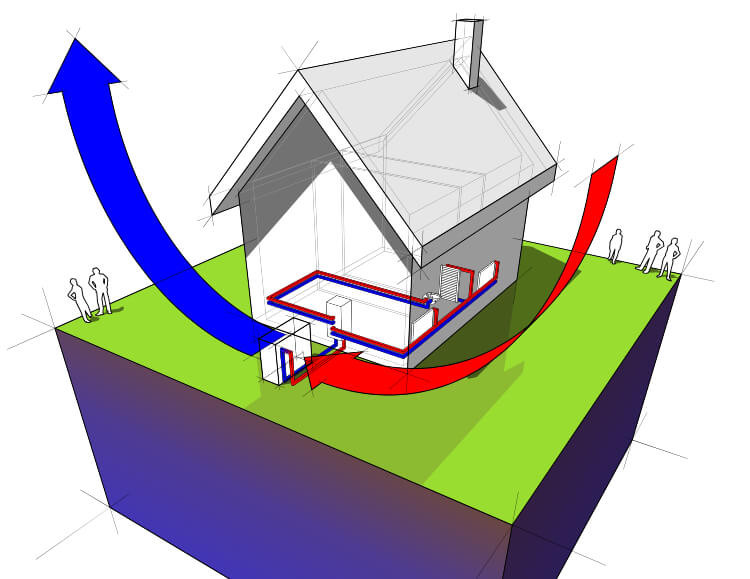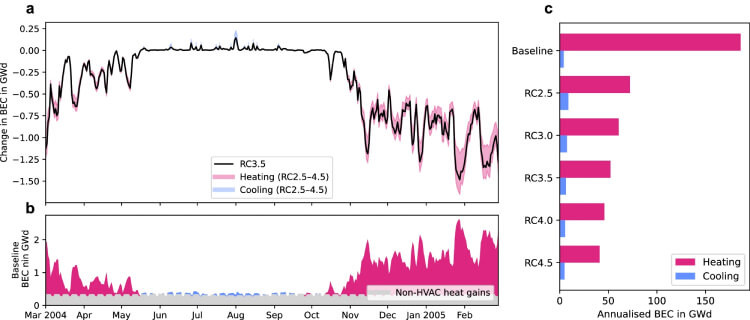Air-to-Air Heat Pumps: CO2 Emission Reduction Potential
Technical Analysis | 30-07-2024 | By Liam Critchley

Key Things to Know:
- Residential heating accounts for 17% of energy consumption in the EU and 11% globally, contributing to around 8% of the world's total carbon emissions.
- Heat pumps, particularly air-to-air heat pumps (AAHPs), offer a highly efficient and electrically driven alternative to traditional fossil fuel heating systems, potentially reducing energy usage and greenhouse gas emissions.
- The efficiency of AAHPs can significantly reduce building energy consumption by 57-76% and electric energy consumption by 6-47%, even during cold spells.
- Transitioning to AAHPs in regions like Toulouse, which utilise low-carbon energy sources, can lead to substantial reductions in CO2 emissions and improvements in urban environmental sustainability.
The Role of Heat Pumps in Reducing Global Energy Consumption and Carbon Emissions
Residential heating accounts for 17% of energy consumption in the EU and 11% across many of the countries outside of the EU. This energy consumption roughly corresponds to around 8% of the world's total carbon emissions.
Heat pumps have emerged as a potential technological solution for creating highly efficient and electrically driven heating systems that can reduce both energy usage and greenhouse gas emissions—potentially becoming a sustainable alternative to fossil fuel systems. There is the potential in areas that already use a lot of reduced emission energy generation technologies—such as in France, where nuclear power is popular—to significantly improve the carbon footprint and environmental impact of the local energy ecosystem.
Heat pumps move thermal energy from a cold region to a warmer region, and depending on where the energy is sourced and eventually released, there are different types of heat pumps that exist. The most common type around the world is air-to-air heat pumps (AAHPs).
However, the use of heat pumps is regionally dependent because some studies have shown that they can be less effective in certain regions of the world, such as Arizona in the U.S., as well as being less cost-effective (but effective in carbon reduction) in countries such as the UK. The variability in effectiveness/economic feasibility in different countries is prompting new studies looking at how heat pumps can impact local carbon emissions and energy usage, with the latest study looking towards France—and more specifically, the local energy ecosystem of Toulouse.
Energy Efficiency of AAHPs in Toulouse
A recent study has looked at the impacts of switching conventional space heating—that is powered by both electric and gas sources—with AAHPs in Toulouse. The researchers used an integrated modelling approach in this study that combined heating, ventilation and air conditioning (HVAC) models with building energy models (BEMs), urban canopy models (UCMs) and numerical weather prediction (NWP) models. This combination of models was used to calculate the potential impact of AAHPs on energy consumption, urban climate dynamics, and CO2 emissions.
Furthermore, the study highlighted that transitioning from fossil fuel-based heating systems to AAHPs can significantly reduce the anthropogenic heat flux in urban areas. This reduction, estimated to be between 50% to 80%, underscores the potential of AAHPs to lower urban temperatures, thereby contributing to the mitigation of urban heat island effects.
The study showed that AAHPs could reduce the building energy consumption (BEC) by 57-76% and the electric energy consumption (EEC) by 6-47%. This reduction in heating energy consumption suggested that AAHPs could realise virtually zero local heating-related CO2 emissions if implemented in Toulouse. Even during cold spells—where the near-surface air temperature is reduced by around 0.5°—the efficiency of AAHPs is not compromised, making them a suitable technology for almost all urban microenvironments. If temperatures are too low, it can reduce AAHP efficiency, so that needs to be considered in some regions of the world.
To further illustrate the impact of transitioning to AAHPs on building energy consumption in Toulouse, the following figure provides a comprehensive view of the changes in both heating and cooling energy requirements. The figure highlights the substantial reductions in energy consumption achieved through the adoption of AAHPs, demonstrating their efficiency and potential for significant energy savings.

(a) Time series of daily averaged changes in building energy consumption (BEC) in the Toulouse agglomeration from the baseline, measured in gigawatt days (GWd), showing the median rated coefficient of performance (RC) scenario (RC3.5, solid black line) and the heating (pink) and cooling (blue) range for RC between 2.5 and 4.5 (shaded area); (b) baseline daily averaged BEC broken down into heating (pink), cooling (blue), and non-HVAC (heating, ventilation, and air conditioning) heat gains such as lighting, electrical appliances, and domestic warm water (grey; mean: 0.32 GWd, n = 365 samples) components; and (c) annualised BEC for heating (pink) and cooling (blue).
CO2 Emission Reduction Potential of AAHPs in Toulouse
It's also important to note that the efficiency of AAHPs, as represented by the coefficient of performance (COP), tends to decrease in extremely cold conditions. This decline in efficiency requires careful consideration in energy planning, particularly in regions with harsh winters, to ensure the stability and reliability of the local energy grid. This emphasises the need for robust energy integration strategies to prevent potential overloads.
The heating mix utilised in Toulouse shows that there could be large energy savings, but this is because France has a lot of renewable energy sources that can be utilised. In cities where gas and fossil fuels prevail as the energy source, the energy and carbon savings could be much lower, and in some cases, the study highlighted that the energy consumption could potentially increase in high fossil fuel cities.
For instance, previous studies have indicated that in regions heavily reliant on fossil fuels for electricity generation, the shift to electric heat pumps might not always lead to lower CO2 emissions. This scenario is particularly evident in parts of the United States, where the electricity grid is predominantly powered by fossil fuels, resulting in increased heating costs and emissions when transitioning to electric heat pumps.
There are also other factors that need to be considered, especially the impact on the local electrical grid because the efficiency of AAHPs was found to vary under different conditions. Therefore, the local grid needs to be reliable to accommodate more complex heating systems, and the study performed recently has highlighted that you need to match heating system transitions with sustainable electricity generation to maximise the environmental benefits.
Moreover, the study from Nature Communications stresses the significance of continuous monitoring and quality control in maintaining the effectiveness of AAHP systems over time. Implementing AI-based models can standardise diagnostic processes, reducing variability in human analysis and ensuring consistent high-quality performance of AAHPs across different urban settings.
As urban centres grow and evolve, AAHPs present an opportunity towards more sustainable heating, but any strategy for implementing them will require the various infrastructural and technological intricacies—from the electrical grid and variability in AAHP efficiency during colder weather—to be considered.
Potential Impact of AAHPs on CO2 Emissions in Toulouse
Additionally, while AAHPs offer significant potential for reducing energy consumption and emissions, the rebound effect—where increased efficiency leads to higher overall energy use due to reduced operational costs—must be carefully managed. Empirical evidence from various regions indicates that the rebound effect could offset some of the anticipated energy savings, highlighting the need for comprehensive policy measures to maximise the net benefits of AAHP deployment.
In the Toulouse study, the AAHP's potential to improve energy efficiency and reduce the reliance on electrical heating was mainly based around environments that were heated by resistive elements. While this is the case for Toulouse, it was found that local regions need to understand their local energy landscape and how heating practices play a key role in energy reduction, as well as understanding the delicate balance between temperature, AAHP's efficiency, and energy consumption.
The study also indicated that the deployment of AAHPs in residential buildings could reduce the heating and cooling energy consumption substantially. In the median scenario, this reduction amounted to 72% in heating energy consumption, from 186 gigawatt-days (GWd) to 52 GWd annually, despite a slight increase in cooling energy use during summer months. Such substantial reductions demonstrate the potential of AAHPs to transform urban energy landscapes significantly.
In Toulouse, it was found that AAHPs improve urban environmental sustainability, but mainly by reducing CO2 emissions. The shift towards lower emission heating systems was particularly effective in Toulouse due to widespread use of low carbon electricity, namely nuclear power sources. In 2019, 70.6% of power came from nuclear sources, making it easy to improve carbon emissions in France through the transition from fossil fuel heaters towards all-electric heating systems powered by low-carbon nuclear power.
Furthermore, the study highlighted that AAHPs could significantly reduce local CO2 emissions during winter, a period typically associated with higher energy demand. This reduction is particularly pronounced in urban centres where the combination of high building density and advanced AAHP systems can lead to substantial improvements in air quality and urban climate resilience.
If the AAHPs were powered predominantly by fossil fuel power stations, then the indirect carbon emissions in the winter when the weather is cold would be much higher than the energy produced by local combustion boilers. This is a primary reason why France has worked in this study, and the same rings true for any region that has low-carbon energy sources—be it nuclear power or distributed energy resources (DERs).
Additionally, addressing the environmental impact of refrigerant leaks from AAHP systems is crucial. The most common refrigerants used in residential HVAC systems have high global warming potential (GWP), which poses significant risks to climate goals if not managed properly. Effective regulations and advancements in refrigerant technology will be vital in ensuring the long-term sustainability of AAHP implementations.
Wrapping Up
The study from Toulouse has shown that AAHPs can be used to reduce local energy consumption, improve carbon emissions, and contribute to urban sustainability goals. However, the study has also emphasised that the conditions need to be right for AAHPs to be successful in improving sustainability—with both the local heating structure and the electrical energy sources being two of the key factors. The study has created a framework for analysing different regions of the world which might be suitable for AAHP integration (and which ones may not) to improve local and global electricity consumption and environmental sustainability.
Reference:

